What is Slag in Welding, and How Does It Work? (2024 Guide)
Last Updated on
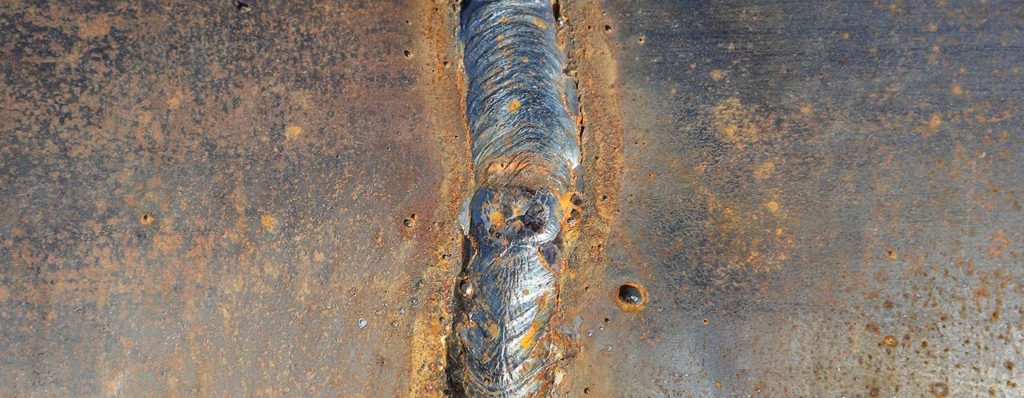
Slag in welding can be defined as “stony waste that is separated from metals during the smelting or refining of ore.” While we are not dealing with ore when we are welding, welding slag is also separated from the base and filler metals during welding. It is then chipped off and cleaned up later on. But it is not pure waste. The slag serves a purpose that helps the structural integrity of the weld.
How Does it Work?
Slag is the byproduct of some arc welding processes. It is formed during welding from flux. When the arc initializes and is stabilized, the filler metal of the electrode begins to liquefy and is deposited into the weld zone. Since the molten metal is fluid and has not cooled, it is much more prone to obtaining defects during the welding process and in the cooling period immediately afterward.
Welding processes that utilize slag have electrodes that either have a flux coating (Shielded metal arc welding), or flux embedded inside a tubular wire (Flux-cored arc welding). This flux is melted with the filler metal and produces gases that create a protective zone for the weld by pushing away other atmospheric gases like oxygen. But not all of the flux evaporates or turns to gas. A remainder of it stays in the weld zone and rises to the top of the weld, leaving a slag, which also serves to protect the weld while cooling.
After the welding is finished, the slag must be removed with a chipping hammer (also called a slag hammer) or a needle gun. Since slag acts as protection for the weld and is non-metallic, it also can cause lack of fusion if additional weld is deposited without removing the old slag.
What are the Different Types of Slag in Welding?
There are many different types of slag in welding. Fluxes are made from a variety of carbonate and silicate materials. Some slag is easier to remove than others. Rutile or acid fluxes, since they are free of fluoride, create a slag that is easier to remove. Basic fluxes create a slag that has calcium fluoride in it, which makes it more difficult to remove. Even though characteristics of flux vary by electrode, the best way to categorize different types of slag, for our purposes, is to sort it by the welding process.
Shielded Metal Arc Welding
Shielded metal arc welding (SMAW) or Stick welding is a process that uses an electrode covered in flux. The metal is deposited when the electrode melts along with the flux. This creates a slag that then needs to be chipped off. It is important that all of the slag is removed before adding more weld.
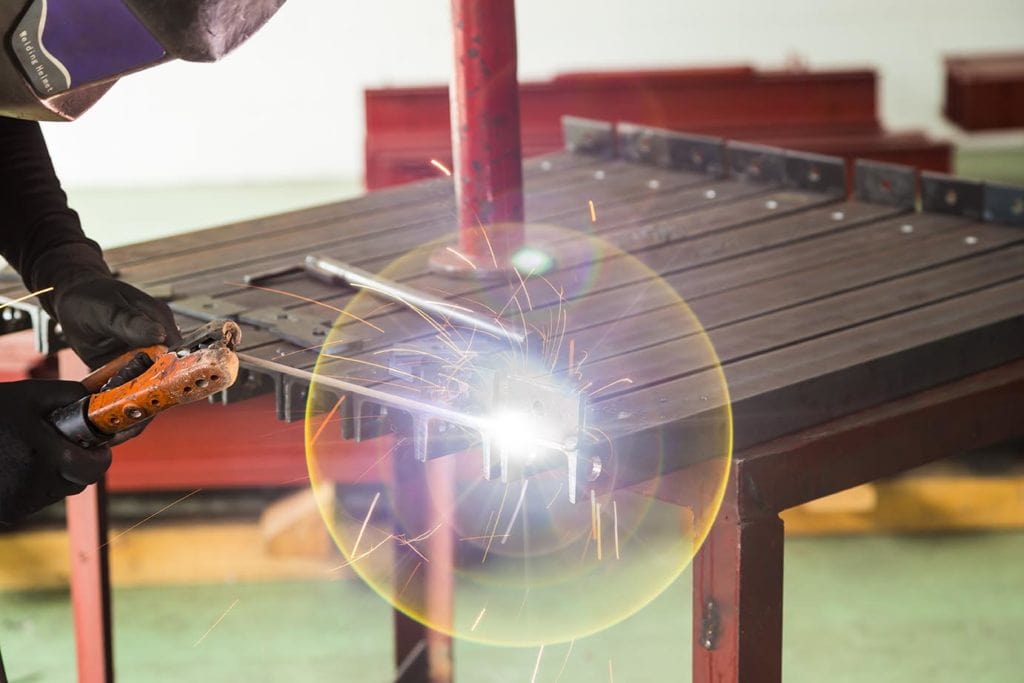
Dual Shield Flux-Cored Arc Welding
Dual Shield Flux-Cored Arc Welding (FCAW-G) is a semi-automatic welding process that deposits the electrode filler metal from a wire feeder. The wire is tubular and filled with flux, hence the name ‘flux-cored.’ This flux alone is not enough to protect the weld, but additional coverage from a shielding gas is required. This is why this process is also called Dual Shield.
It is characterized by a rather smooth arc which also results in an equally smooth slag. In almost all instances, this slag is exceptionally easy to remove, oftentimes in one piece. This makes Dual Shield different from its counterpart, Self-Shielded.
Self-Shielded Flux-Cored Arc Welding
Self-Shielded Flux-Cored Arc Welding (FCAW-S or Innershield) uses the same equipment as Dual Shield. However, the flux used in this process is self-sufficient and does not require additional gas coverage. The arc is less smooth since it works more in the manner of a globular transfer (as opposed to spray arc). This means that the transfer moves across the arc in large molten droplets. This type of welding is used outdoors where gas coverage would be blown away by the wind. The slag can be difficult to remove.
Submerged Arc Welding
Submerged Arc Welding (SAW) uses a metal core wire and uses a wire feeder much like Flux-cored welding. However, there is usually no flux included in the wire to form the slag. Since this process is most often used for automation, the weld path is set and a granular, conductive flux is laid in the weld path. More efficient is a flux hopper, that dispenses the flux while welding. This flux is fusible and turns in the slag. At the same time, it helps stabilize the arc underneath the flux. This is why it is called ‘submerged’ arc welding since the arc is not visible outside of the flux. The slag formed is typically easy to remove.
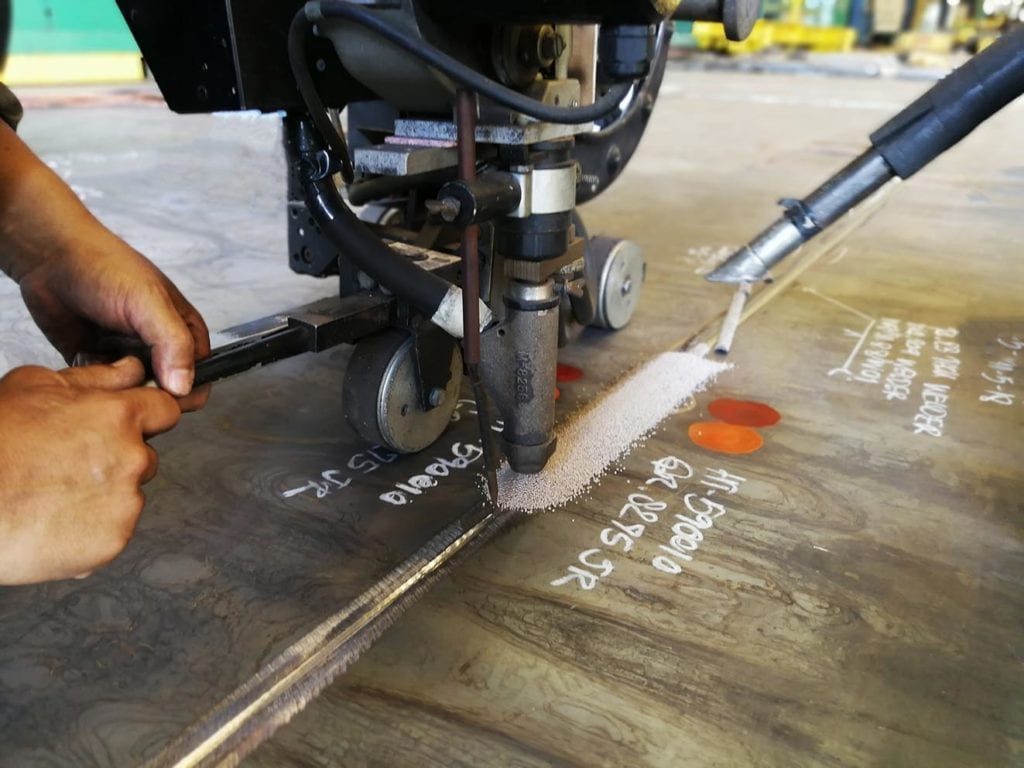
Electroslag Welding
Electroslag Welding (ESW) is a single-pass process designed for welding thick plates, typically greater than 1¼ inches of thickness. It has been described more as a fusion process rather than welding. Flux is added to the joint ahead of time. The electrode is inserted on top of the flux. Since flux is not a good conductor of electricity there is no arc. Instead, what happens is that resistance between the electrode and the workpiece generates heat to melt the pool of flux. After it becomes molten, more flux is then added to stabilize the arc and join the molten slag pool with the pool of filler metal.
Where is it Used?
Slag is used anywhere you see FCAW, SMAW, SAW, and ESW. These types of welding are more present in structural steel fabrication shops as well as at job sites that are working on structural steel. The protective nature of the slag is helpful to prevent defects caused by inclement weather. Using MIG welding, or hardwire, would not work in inclement weather or on a lot of structural steel, since it does not penetrate as well as the above processes.
Advantages of Slag in Welding
The obvious advantage of slag is that it helps protect the weld from outside defects during the welding process. Slag can also preserve the intended shape and proper dimensions of weld beads, something which can be critical depending on the application.
Disadvantages of Slag in Welding
Though the intention of welding processes that utilize flux and slag is to have it rise to the surface during welding, that is not always the case. Probably the biggest disadvantage is that you run the risk of having slag inclusions and lack of fusion. While slag is made to prevent defects such as porosity and wormholes, it can also cause defects of its own if the welder does not clean his welds or use proper technique.
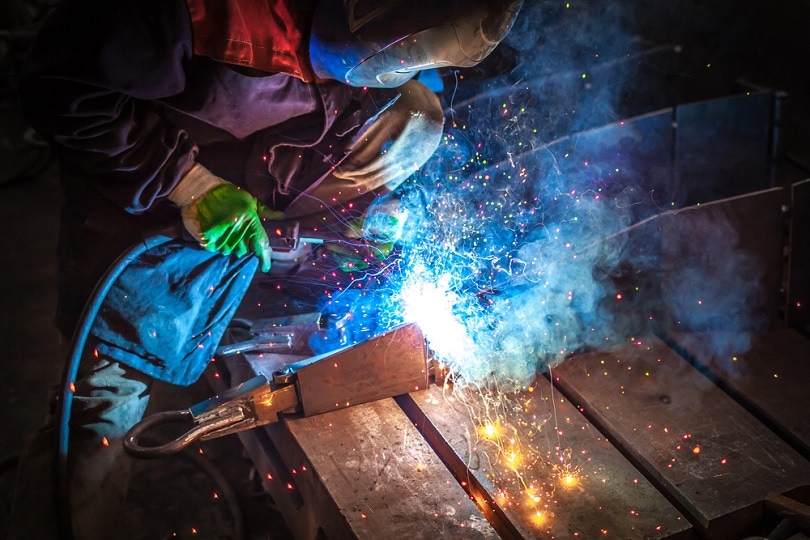
Frequently Asked Questions (FAQs)
Can You Leave Slag on a Weld?
The short answer is no. You should always clean your welds. However, if it is the final pass of a multi-pass weld, unless you plan for the weldment to be painted, leaving slag on top should not be a problem. This often happens with fixtures and other temporary structures used to help fabricators get the real work done.
Now, there are times when people do not follow protocol. Sometimes Dual Shield FCAW welders will weld the root pass of a multi-pass fillet weld and chip off the slag according to the procedure. However, the next two successive passes which compose the second layer of weld will not have the slag chipped off between them. This is only because the slag is already easy to remove, and the puddle can get hot enough to cause the previous slag to rise to the top of the new puddle. Again, this is not recommended (especially for critical welds) and it still can cause slag inclusions. But in a situation like this, it should not harm the overall integrity of the weld as long as the slag is chipped off between layers of weld.
- See also: What Does DCEP Mean in Welding?
What Causes Slag Inclusions?
Slag inclusions are usually caused by poor cleaning of weld in between passes. It can also be caused by bad welding technique. For example, FCAW is intended to be welded at a slight drag angle so that the electrode wire can trail behind the puddle. If you change that angle to pushing the puddle, you can potentially be welding over your previously formed puddle and therefore trapping slag. Slag inclusions are usually caused by user error.
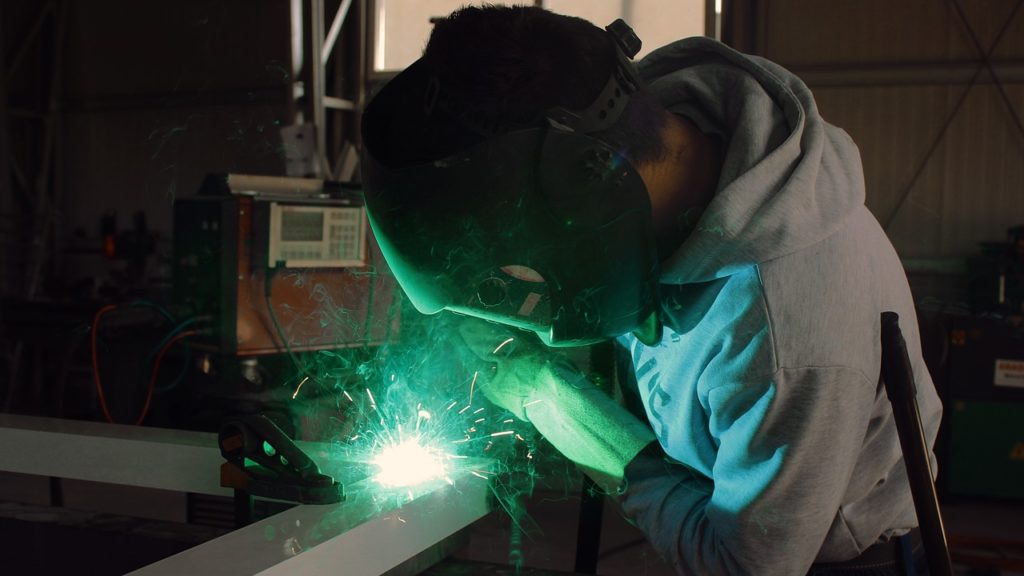
What are the Best Ways to Remove Slag between Fillet Weld Passes?
The simplest way to remove slag is to use a slag hammer. One end is pointed, and the other end has a flat edge. Another way is to use an air tool like a needle gun. Just pull the trigger and hit it up against your weld. This is helpful for weld with slag that is difficult to remove, like Self-shielded.
Another method is to use an angle grinder. While not a good go-to method for removing slag, it can be more efficient than using a needle gun sometimes. For example, if you are Stick welding a pipe joint using an E6010 rod to lay the root pass, because of the fast freeze nature of the slag combined with the whip-and-pause technique of welding, the slag will come off in small pieces. Use an angle grinder to clean the root pass and flatten out the weld for your following passes.
Conclusion
Slag is messy. It gets everywhere when you are welding and causes a lot of smoke. Yet this is how it serves its purpose. But without proper cleaning and metal preparation, it can cause problems that can affect the structural integrity of your welds. The annoying work of cleaning your weld will save you later from carbon-arc gouging or grinding into your defective weld to fix it.
Featured Image Credit: K.Kargona, Shutterstock
